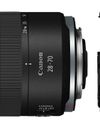
A tripod is essential when taking landscape photos, allowing you to take your time to fine-tune your composition, as well as enabling long exposures that blur moving elements while simultaneously keeping the static parts pin-sharp. But the head attached to the tripod is often overlooked.
Many budget tripods come with a pan-and-tilt head, so you may be familiar with the basic two-axis control and long panning handle that makes it easy to create a smooth panning motion.
However, these budget models are often made for video and not ideal for photography. You can tell they’re geared to videography if the legs are braced together – on a photographic tripod, you want these to be unbound, with the ability to change the leg angles freely, so you can get lower to the ground if needed for your shot.
THE MISSION
To take fantastic abstract panning blur photos with a pan-and-tilt tripod head
Time needed
One hour
Skill level
Beginner
Kit needed
Canon EOS DSLR or EOS mirrorless
Kit lens
Tripod
A pan-and-tilt tripod head
Professional tripods, starting at around £100, usually have the option to switch the head, from say a three-way to a ball head, pan-and-tilt or even a more specialized head, such as a panoramic or gimbal head.
هذه القصة مأخوذة من طبعة September 2022 من PhotoPlus : The Canon Magazine.
ابدأ النسخة التجريبية المجانية من Magzter GOLD لمدة 7 أيام للوصول إلى آلاف القصص المتميزة المنسقة وأكثر من 9,000 مجلة وصحيفة.
بالفعل مشترك ? تسجيل الدخول
هذه القصة مأخوذة من طبعة September 2022 من PhotoPlus : The Canon Magazine.
ابدأ النسخة التجريبية المجانية من Magzter GOLD لمدة 7 أيام للوصول إلى آلاف القصص المتميزة المنسقة وأكثر من 9,000 مجلة وصحيفة.
بالفعل مشترك? تسجيل الدخول

The Art of Copying Art - James Paterson shows you how to use your Canon gear to capture artwork and paintings the right way with simple camera and lighting skills
Whether you want to capture a painting like the above, digitise old prints or reproduce any kind of canvas, there's real skill in capturing artwork with your camera. Not only do you need the colours to be accurate, you also need to master the spread, angle and quality of the light to minimise glare and show the work at its best.This painting by the artist Bryan Hanlon has a wonderfully subtle colour palette. To reproduce the painting in print and digital form, it needs to be captured in the right way.

Fright night
Canon photographer and digital artist Alexander loves to craft incredible fantasy scenes with a spooky horror twist

Sharpen your shots with DPP
Sharpening a digital image also increases contrast at the edge of details

CANON ImagePrograf PRO-1100
Deeper blacks, better bronzing, greater lifespan and 5G Wi-Fi -Canon's new printer is full of new tech, says

Canon's new 'kit lens' is actually a half-price f/2.8 trinity lens!
The Canon RF 28-70mm F2.8 IS STM lacks a red ring, but borrows premium features from its L-series siblings

DREW GIBSON
Pro motorsports photographer Drew on why he hasn't (yet) switched to Canon's mirrorless system, why old-school techniques can be the most reliable, and the lessons learned from more than a decade shooting the world's biggest car brands

Up in smoke
Make a smoky shape in Affinity Photo and get to grips with the amazing Liquify Persona under the guidance of James Paterson

Expand your creativity with Generative Fill
Photoshop's Al-powered feature brings revolutionary new tools to image editing. James Paterson reveals all...

Turn your images into vintage postcards
Wish you were here? Sean McCormack explains how you can give your summer photographs a vintage postcard look

The Angel Malibu
Light painting an American movie producer in the Wadi Rum Desert in Jordan was a highly unlikely evening out for David!